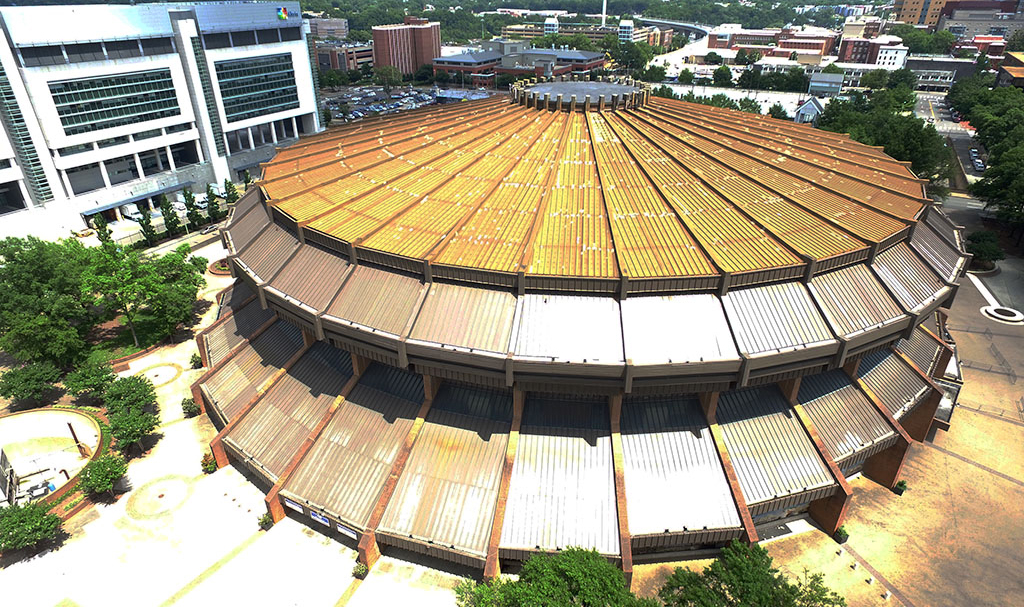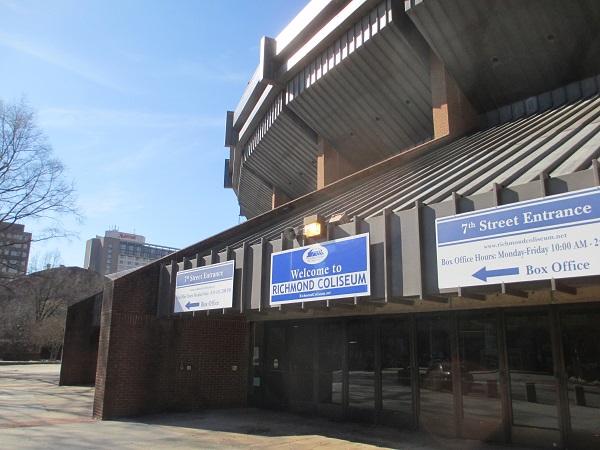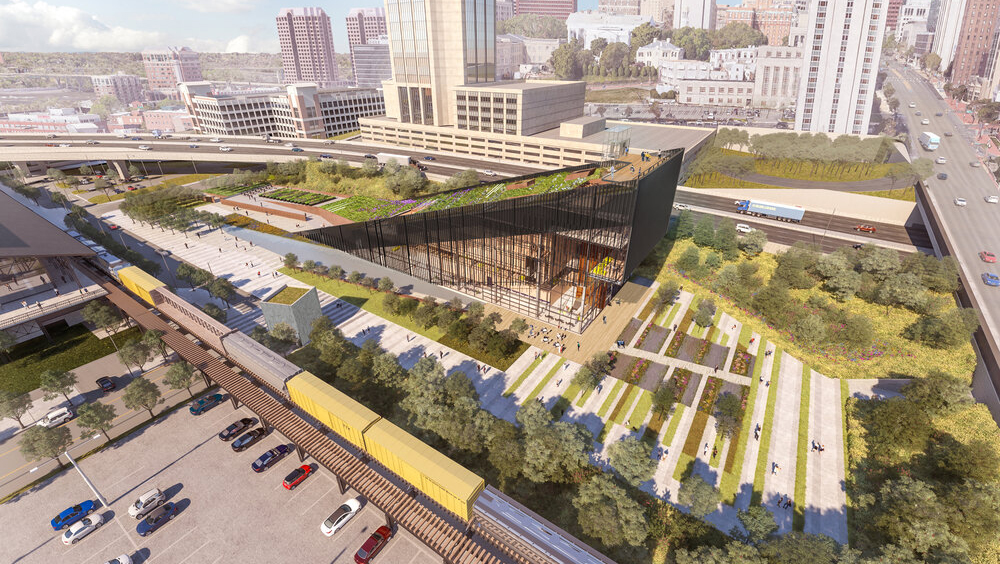
The city is starting to salvage the Coliseum to ready the shuttered structure for demolition. (BizSense file images)
As it rolls out a draft plan for the Shockoe Bottom area, the City of Richmond is preparing to implement a separate effort that calls for demolishing the Coliseum — even though that latter plan has yet to be adopted.
Administrators announced Monday that the city is moving forward with a process to salvage the 50-year-old arena, in anticipation of the City Council adopting the proposed City Center Small Area Plan, which recommends replacing the Coliseum with a mix of commercial, residential and office buildings.
The same day, the city released its draft Shockoe Small Area Plan, a years-in-the-making document aimed at guiding growth in and around Shockoe Bottom.
The public is encouraged to review and provide feedback on the Shockoe plan, which would be incorporated into the city’s Richmond 300 master plan that was adopted in December.
A similar public engagement process was done for the City Center plan, which was released last month and presented to councilmembers and the Planning Commission.
But while the public comment period on that plan ended last week, the City Center plan has yet to be voted on by the commission or council, which may or may not agree with the demolition recommendation. Some observers have called for the structure to be retained and rehabbed, rather than replaced.

The city envisions the Coliseum being torn down and replaced with a mix of commercial, residential and office buildings.
The city’s announcement emphasized that demolition would begin “only once the (City Center) plan passes Richmond City Council,” adding that pre-demolition salvage is “a standard cost-saving and safety measure.” Proceeding with the salvage process, the city said, would prepare the site for demolition and defray costs to operate and maintain the structure, which the city shuttered in late 2018.
Administrators have said maintaining the Coliseum has cost the city $800,000 annually. And with plans in place for a new regional arena in Henrico County, they’ve said they are not looking to reopen it.
Sam Schwartzkopf, a city spokeswoman, said the decision to start the salvage process is meant to get the building ready for demolition sooner. Items to be salvaged include boilers, chillers, compressors, stadium chairs, lights and fixtures, and scoreboards.
The salvage contractor the city is working with and project cost were not provided in time for this story.
“The sooner salvage begins, the sooner the city can act, upon passage of the small area plan,” Schwartzkopf said. “We’re confident in the plan’s vision for our downtown core, especially because it’s in line with Richmond 300, the master plan that has already unanimously passed City Council.”
Feedback sought on Shockoe plan
Meanwhile, public comment on the Shockoe draft plan is being accepted through Aug. 27. Feedback received could be used to shape an amended proposal that would then be presented to the Planning Commission and City Council, likewise for potential adoption and inclusion in Richmond 300.
In the works for two years, the 200-page document stems from several planning efforts that led to the formation of the Shockoe Alliance group, which helped guide the plan’s development. Like Richmond 300, it envisions how the Shockoe area could develop by the year 2037 – the city’s tricentennial.
The plan recommends several long-term goals, including development of a “heritage campus” and park commemorating the area’s history as a slave-trade hub — one of six so-called “big moves” that are encouraged to be taken in the plan’s first five years.
Also recommended are four “priority projects” to be implemented in the first 12 to 18 months.
Those include hiring a cultural resource management firm to prepare an archaeology map and further research sites such as the African American Burial Ground; preparing a request for proposals to design the heritage campus and advance short-term projects; exploring a temporary slavery museum space inside Main Street Station; and implementing zoning recommendations.
The draft plan can be downloaded here and will be presented in an in-person meeting Aug. 3 and a virtual meeting Aug. 4. Details on those meetings and additional information is available on the website.

The city is starting to salvage the Coliseum to ready the shuttered structure for demolition. (BizSense file images)
As it rolls out a draft plan for the Shockoe Bottom area, the City of Richmond is preparing to implement a separate effort that calls for demolishing the Coliseum — even though that latter plan has yet to be adopted.
Administrators announced Monday that the city is moving forward with a process to salvage the 50-year-old arena, in anticipation of the City Council adopting the proposed City Center Small Area Plan, which recommends replacing the Coliseum with a mix of commercial, residential and office buildings.
The same day, the city released its draft Shockoe Small Area Plan, a years-in-the-making document aimed at guiding growth in and around Shockoe Bottom.
The public is encouraged to review and provide feedback on the Shockoe plan, which would be incorporated into the city’s Richmond 300 master plan that was adopted in December.
A similar public engagement process was done for the City Center plan, which was released last month and presented to councilmembers and the Planning Commission.
But while the public comment period on that plan ended last week, the City Center plan has yet to be voted on by the commission or council, which may or may not agree with the demolition recommendation. Some observers have called for the structure to be retained and rehabbed, rather than replaced.

The city envisions the Coliseum being torn down and replaced with a mix of commercial, residential and office buildings.
The city’s announcement emphasized that demolition would begin “only once the (City Center) plan passes Richmond City Council,” adding that pre-demolition salvage is “a standard cost-saving and safety measure.” Proceeding with the salvage process, the city said, would prepare the site for demolition and defray costs to operate and maintain the structure, which the city shuttered in late 2018.
Administrators have said maintaining the Coliseum has cost the city $800,000 annually. And with plans in place for a new regional arena in Henrico County, they’ve said they are not looking to reopen it.
Sam Schwartzkopf, a city spokeswoman, said the decision to start the salvage process is meant to get the building ready for demolition sooner. Items to be salvaged include boilers, chillers, compressors, stadium chairs, lights and fixtures, and scoreboards.
The salvage contractor the city is working with and project cost were not provided in time for this story.
“The sooner salvage begins, the sooner the city can act, upon passage of the small area plan,” Schwartzkopf said. “We’re confident in the plan’s vision for our downtown core, especially because it’s in line with Richmond 300, the master plan that has already unanimously passed City Council.”
Feedback sought on Shockoe plan
Meanwhile, public comment on the Shockoe draft plan is being accepted through Aug. 27. Feedback received could be used to shape an amended proposal that would then be presented to the Planning Commission and City Council, likewise for potential adoption and inclusion in Richmond 300.
In the works for two years, the 200-page document stems from several planning efforts that led to the formation of the Shockoe Alliance group, which helped guide the plan’s development. Like Richmond 300, it envisions how the Shockoe area could develop by the year 2037 – the city’s tricentennial.
The plan recommends several long-term goals, including development of a “heritage campus” and park commemorating the area’s history as a slave-trade hub — one of six so-called “big moves” that are encouraged to be taken in the plan’s first five years.
Also recommended are four “priority projects” to be implemented in the first 12 to 18 months.
Those include hiring a cultural resource management firm to prepare an archaeology map and further research sites such as the African American Burial Ground; preparing a request for proposals to design the heritage campus and advance short-term projects; exploring a temporary slavery museum space inside Main Street Station; and implementing zoning recommendations.
The draft plan can be downloaded here and will be presented in an in-person meeting Aug. 3 and a virtual meeting Aug. 4. Details on those meetings and additional information is available on the website.

I’m glad the city is moving on getting rid of the Coliseum. The future coliseum is clearly going to be in Henrico, lets get this into private hands and tax it.
The Richmond Coliseum opened 50 years ago at a time when people were leaving the city and most did not want to go downtown. Times have changed. Today the city center contains some of the most valuable, sought-after property in the metro area. There is no longer a need for the city to build expensive enticements to lure people downtown.
Im not from the area, but I was visiting the area not too long ago. There was a homeless lady outside of it under the part that sticks out (not sure what to call it.) Praying someone has helped her or will help her!
Why didn’t you help her?
Stay or demo is hardly the point; as this article notes; this Mayor does what he wants without permission, without public comment, and outside his authority.
Executive, even strong Mayors, are here to execute the laws, regulations, and budgets approved by the legislature. Someone show me where in the current capital budget has a line item for salvage/demo of the Coliseum? Are they going to offer items to the public or just send it to landfill? Where was the public bid???
“Salvage” is a term that implies monetizing components in advance of demolition. Salvaged components don’t get sent to the landfill, they get sold or recycled.
Spoken has some who never worked in local government or for City. When we “savaged” part of 6th Street and Thalhimers buildings prior to demo we paid a private company to come Into review the buildings and then paid them to dispose of items that they thought might have some value but after removing it was decided it would go to the landfill. In the end we (the city) paid the salvage company several hundred thousand dollars. So I ask again where is the budget line item.
Hello Commercial property folks:
Why does it cost 800k to maintain a closed facility?
Other than a few guards to patrol and make sure people are kept ou, if its not going o be used why does i cost that much?
Its not like they need to repair anything.
Does this seem excessive to anyone else?
Likely utilities costs. That’s a big place to heat and cool (probably to lower than usual settings) and then the little stuff like security, etc.
Do you need to heat and cool it while it is waiting to be torn down?
It depends if its been fully mothballed, no. If actively sprinklered, yes it needs heat. Cooling (more dehumidification) if you don’t want it to become a mold and funji growing facility.
Thanks. But if the plan was always to tear it down that seems like a waste, but thanks.
Good question Ed; Most mothballed City faculties they turn off the electricity. Thus hearing and cooling is not even an option.
Electricity is typically left so the fire alarm system can be active. Even with no one using it, you don’t want it to catch fire and endanger neighboring buildings.
True.
thanks for the info